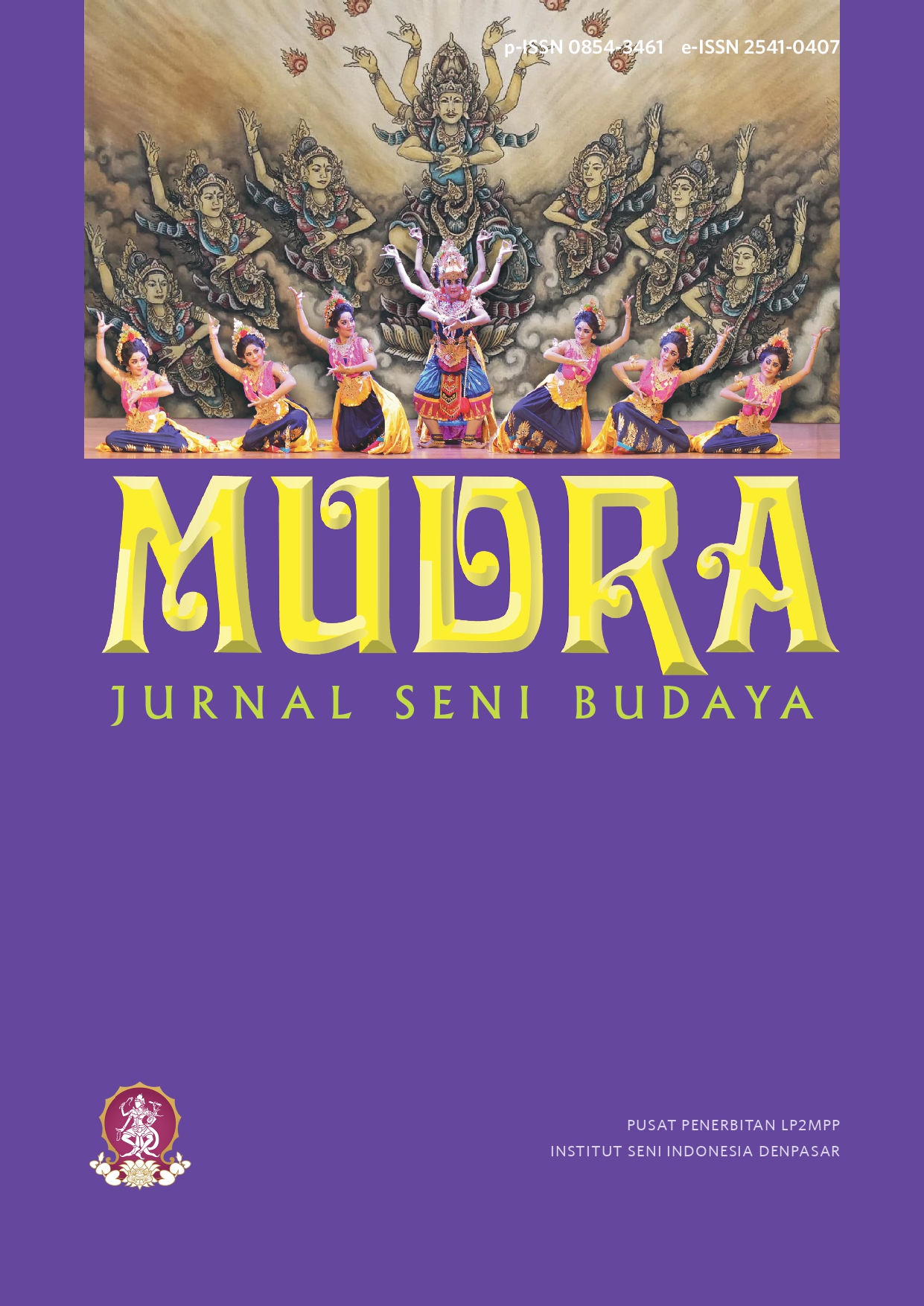The Dancing Cross
Contextualizing Religious Symbol in Balinese Context
DOI:
https://doi.org/10.31091/mudra.v38i4.2439Keywords:
dancing cross, contextualization, symbol, BalineseAbstract
Religious symbol is the generic word for all kinds of religious signs of the divine. It includes myths and religious narratives, theological ideas, particular notions such as karma or sin which are defined in one or more symbol systems, religious acts such as liturgies or private meditations that move through and overlay various symbol systems, as well as architectural and artistic symbols with religious content, books, songs, devotional objects, and the like. Generally, it can be referred to a religious object and can bear a religious meaning. This study aims to identify the meaning of a contextualized religious symbol in the Bali Church which is known as ‘the dancing cross’. The theory applied in this study is semiotic theory which in this case is structural semiotics. The source of the data are texts that discuss about the cross symbol as well as the results of interviews with the creator of the dancing cross symbol, Nyoman Darsane. This study confirms that the dancing cross, which is widely used by Christians who are members of the Protestant Christian Church in Bali is considered as the product of regionalization or contextualization of the cross which is the crux of Christian life and worship. The shape of the dancing cross is transformed from the universal shape of the cross which is consisted of two bars leading to a T-shaped cross which base stem is longer than the other three arms but crooked at the bottom like a dancer who is in left agem position. The results of the analysis through the utilization of structural semiotics in terms of syntagmatic and paradigmatic relations revealed some important points namely the contrastive meaning of the cross before and after the time of Jesus Christ as the sign of shame which covers a curse, a stumbling block and foolishness and the sign to be glorified which covers salvation victory and obedience. Other important points to be revealed are the contextual shape of the cross that can be aligned as a dancer who is in left agem position and the contextual meaning of the cross which leads to the sign of obedience of God’s people or the disciples to carry or dance the cross in accordance with the example given by Jesus Christ.
Downloads
References
Aritonang, J. S. (2012). Dinamika GKPB Dalam Perjalanan Sejarah. BPK Gunung Mulia.
Bacquet, S. (2017). Religious Symbols and the Making of Contemporary Religious Identities. In R. Sanberg (Ed.), Religion and Legal Pluralism (p. 300). Routledge.
Bailey, J. (2007). What is Contextualization and Is It Biblical. In J. Armstrong (Ed.), Contextualization and The Church. Asian Cross Cultural Training Institute.
Chandler, D. D. (2007). Semiotics: the basics. Basics (Routledge (Firm), xviii, 307 p. https://doi.org/10.1016/S0378-2166(02)00176-5
Cross. (2022). In Encyclopedia Britanica (p. 3). Encyclopaedia Britannica, Inc.
Danesi, M. (2021). Analyzing Cultures: An Introduction and Handbook. Indiana University Press. https://doi.org/10.2979/AnalyzingCulturesAnI
Dewi, L, Sariyasa, Suweken, G. (2022). Ethnomathematics in Balinese Dance Movements and Its Potential for Learning. International Journal of Science and Research (IJSR), 11(10), 207–218. https://doi.org/10.21275/SR22731071301
Friskaliana, D. (2020). SYMBOLISM IN ALEXANDER PUSHKIN’S THE QUEEN OF SPADES SHORT STORY. Ilmu Budaya: Jurnal Bahasa, Sastra, Seni, Dan Budaya, 4(4), 674–690. https://e-journals.unmul.ac.id/index.php/JBSSB/article/view/3189
Hesselgrave, D. J. and Rommen, E. (1989). Contextualization: Meanings, Methods, and Models. Baker Books.
Jha, A. K. (2017). A Semiotic Analysis of portraying Gender in Magazine Advertisements. IOSR Journal Of Humanities And Social Science (IOSR-JHSS), 2(5). https://doi.org/10.9790/0837-2205110108
Johns, J. (2019). Ornamentations Around The Symbol of The Cross: A Comparative Overview. The Xavier’s Research Journal., 10(1), 45–55. https://www.researchgate.net/publication/333878226_Ornamentations_Around_The_Symbol_Of_The_Cross_A_Comparative_Overview-XPLORE_RESEARCH_JOURNALVol_10_Issue_1_Dec_2019_ISSN_2249_-_1878?enrichId=rgreq-7435fca8a6a89758902e65a4e3da870a-XXX&enrichSource=Y292ZX
Kanu, F. A. (2018). The Sign of the Cross. Hansel Communications Ltd.
Neville, R. C. (2001). Symbols of Jesus: A Christology of Symbolic Engagement. Cambridge University Press.
Park, E.-Y. (2019). Design of Data Model and Analysis of Association Rule for Cross Symbol Design. Journal of Digital Contents Society, 20(12), 2375–2381. https://www.dcs.or.kr/
Piliang, Y. A. (2010). Semiotika Sebagai Metode dalam Penelitian Desain. In T. Christomy & U. Yuwono (Eds.), Semiotika Budaya. Pusat Penelitian Kemasyarakatan dan Budaya.
Rizqiyah, I. (2017). The Symbolic Meaning of Ruby Red in Kerstien Gier’s Novel. Universitas Islam Negeri Maulana Malik Ibrahim.
Septiani, D. L., Rejeki, S., & Widisanti S, N. M. (2019). THE RELATIONSHIP BETWEEN SYMBOL AND MEANING IN THE FILM ZOOTOPIA. Journal Albion: Journal of English Literature, Language, and Culture, 1(1). https://doi.org/10.33751/albion.v1i1.1120
Walker, D. F. (2014). Konkordansi Alkitab. BPK Gunung Mulia.
Wan, E. (2003). Critiquing the Method of Traditional Western Theology and Calling for Sino-Theology. https://ojs.globalmissiology.org/index.php/english/article/view/438/1126
Wilson, and Taylor, N. R. (2015). The A to Z Guide to Bible Signs and Symbols: Understanding Their Meaning and Significance. Baker Books.
Wilson, J. (2007). Critical Contextualizaton. In J. Armstrong (Ed.), Contextualization and The church. Asian Cross Cultural Training Institute.
Yehoshua, A. (2016). The Christian Cross. https://seedofabraham.net/
Downloads
Published
How to Cite
Issue
Section
License
Copyright (c) 2023 Ni Made Diana Erfiani, Nyoman Tri Sukarsih, I Gusti Agung Sri Rwa Jayantini

This work is licensed under a Creative Commons Attribution-NonCommercial-ShareAlike 4.0 International License.
- Copyright on any open access article in a journal published by Mudra Jurnal Seni Budaya is retained by the author(s).
-
The Creative Commons Attribution License 4.0 formalizes these and other terms and conditions of publishing articles.









